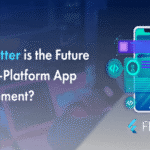Mobile AppHow to Improve Mobile App Retention: Tactics for 30–90 Day Stickiness

Table of Contents
Introduction: Retention Is the New Acquisition
Most businesses obsess over downloads. But what truly matters isn’t how many people install your app—it’s how many stick around. According to AppsFlyer, only 25% of users open an app again after Day 1, and by Day 30, the number drops to 4% for many verticals.
High retention is a clear signal that your product delivers value, satisfies user needs, and creates habits. In fact, improving retention by just 5% can increase profits by 25–95% (Bain & Company).
If you’re investing in growth, your first step should be retaining users. As a leading mobile app development company in Chennai, we’ve built and scaled apps where retention is baked into every line of code and pixel of UI.
What Is Mobile App Retention? Why It Matters
Retention rate refers to the percentage of users who continue to use your app over a given period—typically measured over Day 1, Day 7, Day 30, and Day 90.
Why it matters:
- High retention = real value delivered
- It improves app store rankings
- Reduces Customer Acquisition Cost (CAC)
- Attracts investors and improves valuation
- Drives organic word-of-mouth and referrals
In short: retention is the ultimate proof of product-market fit.
Understanding 30–90 Day Stickiness: The Critical Window
Day 1–30: The Onboarding and Habit Formation Phase
Users are exploring. First impressions, app performance, and early value delivery shape whether they’ll return.
Day 30–60: The Engagement & Trust-Building Phase
If users find recurring value, they start building usage habits. This is where engagement loops, content depth, and push strategies work best.
Day 60–90: The Loyalty & Monetization Phase
Users become regulars. They may refer friends, upgrade to premium, or integrate the app into their daily life. Now is the time to reward and deepen the relationship.
Benchmark Retention Rates by Industry
Industry | Day 1 Retention | Day 30 Retention | Day 90 Retention |
Fintech | 32% | 15% | 10% |
eCommerce | 28% | 10% | 5% |
Health & Fitness | 30% | 12% | 7% |
Gaming | 26% | 8% | 4% |
Education | 33% | 18% | 12% |
Source: Adjust + Statista 2024
Your goal: outperform your category average through UX, relevance, and re-engagement.
Key Reasons Users Abandon Apps After Install
- Poor Onboarding: If users don’t understand what to do within the first 60 seconds, they leave.
- Slow Load Time: 53% of users abandon apps that take over 3 seconds to load.
- Lack of Value: If users don’t experience a win or benefit fast, they won’t return.
- Too Many Notifications: Over-communication can feel spammy and push users away.
- Bugs & Crashes: Reliability is a minimum expectation.
30–Day Retention Tactics: First Impressions & Activation
1. Streamlined Onboarding
Use tooltips, guided tours, and progress bars to help users understand key features fast. Limit required fields and remove friction.
Pro Tip: Apps with a simplified onboarding process improve Day 1 retention by up to 50%.
2. First-Time User Experience (FTUE) Personalization
Show content or features tailored to user goals. Ask onboarding questions that guide future recommendations.
3. Performance Optimization
Fast, bug-free loading builds trust. We run speed audits and memory profiling during app development to ensure this.
4. Welcome Emails & SMS Nudges
Engage users outside the app. A well-timed welcome email increases the likelihood of users returning by 26% (Braze, 2024).
60–Day Retention Tactics: Engagement Loops & Personalization
1. Behavioral Push Notifications
Send notifications triggered by user actions—abandoned cart, unread messages, or time-based prompts.
Apps using personalized push notifications see 3x higher engagement (CleverTap).
2. Gamification Elements
Add challenges, rewards, badges, or streaks. Duolingo retains users with daily goals and visual progress maps.
3. Content Personalization Using AI
Leverage AI-powered features to tailor feeds, suggestions, or learning paths.
Example: A fitness app recommends routines based on user age, goals, and past workouts.
4. Referral Programs
Incentivize sharing. Offer credits, free access, or gifts for inviting friends. Viral loops improve both retention and acquisition.
90–Day Retention Tactics: Loyalty, Feedback & Evolution
1. Loyalty Programs
Reward consistent users. Starbucks, Amazon, and even local brands use app-exclusive perks to build daily usage habits.
2. In-App Feedback Collection
Ask for feedback within the app. Tools like Instabug or built-in surveys help catch issues before users churn.
3. Monthly Feature Releases
Keep the product fresh. Regularly release new features, integrations, or improvements based on feedback.
4. Exclusive Content or Access
Make loyal users feel special—early access to features, insider communities, or behind-the-scenes updates.
Real-World Case Studies
Case Study 1: Retention Boost in a Learning App (Confidential Signed NDA)
Challenge:
Day 30 retention was only 8% due to weak onboarding and linear content delivery.Our Solution:
- Personalized onboarding questions
- Content unlocks based on engagement
- AI-generated lesson recommendations
- Weekly progress reports via email
Results:
- Day 30 retention rose to 22%
- Daily active users grew by 70% in 3 months
- App rating increased from 3.8 to 4.5
Case Study 2: eCommerce App Engagement (Confidential Signed NDA)
Challenge:
Heavy install numbers, but very low re-engagement after first purchase.Our Solution:
- Added push cart reminders and seasonal promos
- Loyalty point tracker on dashboard
- Re-purchase suggestions via AI
- Referred 1,200+ new users via share offers
Results:
- Day 60 retention improved from 9% to 19%
- Monthly order frequency increased by 2.4x
- Revenue from retained users exceeded new user CAC spend
How TechHeaders Helps You Build Retention-First Apps
As a Chennai-based mobile app development team, we go beyond development:
Retention Strategy Design
We map retention loops from Day 1. Personalized onboarding, gamified modules, and nudge sequences are built into your app roadmap.
Speed & Stability Optimization
We ensure under-2-second load times and 99.9% uptime to prevent churn caused by bugs or slow performance.
AI Integration for Retention
Using ML models, we enable content ranking, churn prediction, and smart notifications tailored to each user’s behavior.
Explore more product growth strategies in our blogs.
Conclusion: Turn Installs Into Loyal Users
Retention isn’t luck—it’s a strategy. From onboarding and gamification to AI personalization and rewards, every detail impacts whether users return.
Rather than chasing downloads, focus on building user habits and long-term loyalty. You’ll lower CAC, improve LTV, and build a sustainable, defensible business.
If you’re looking to build a retention-optimized app with real business outcomes, work with a high-retention mobile app development company in Chennai.
Let’s build your next high-retention product. Contact us today.
FAQs
1. What is a good 30-day retention rate?
It varies by industry, but anything above 20% is considered strong. Top apps achieve 30–40%.
2. How often should I update my app to keep users engaged?
Aim for biweekly or monthly updates—whether it’s features, UI, or performance tweaks.
3. Do push notifications really work for retention?
Yes, when used correctly. Personalized, behavior-based push notifications can triple user engagement.




